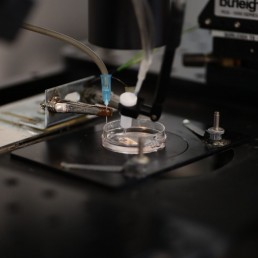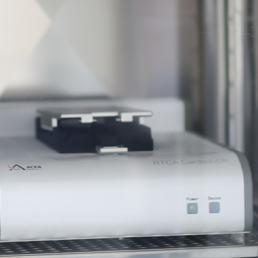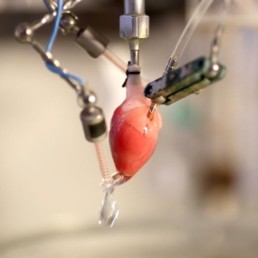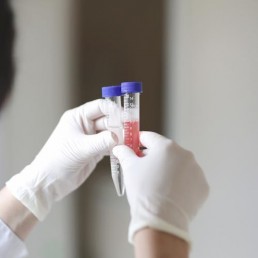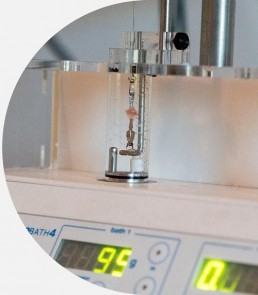
Cardiac Pharmacology

Cardiac Pharmacology in organ baths
Whatever the therapeutic area, some compounds show direct effects on cardiac contractility or rhythm. That is why we perform secondary pharmacology (targets or off-targets dependent) by using the isolated organ baths under normal or diseased conditions. However, these effects are generally detected in the later stage of drug development. Among our other models the isolated cardiac tissue in organ baths set-up offers an predictive ex vivo model to detect drug-induced cardiac pharmacology such as chronotropism with the spontaneously beating right atrium model and inotropism with the papillary muscle model. The variation of cardiac contractility or rhythm is representative of variation of cardiac function and hemodynamic.
Chronotropic effects
Cardiac frequency assays & secondary pharmacology
Frequency assays aim to identify potential chronotropic effects (tachycardia or bradycardia) early during drug development. Numerous clinically approved drugs reported to modify beating rate increasing the risk of cardiac disfunction (arrhythmias, tachycardia, syncope). As a result, a large number of drugs have been contraindicated with the use during late stage of clinical trials or from the market.
What is the added value of such a study?
- Strongly recommended for the secondary pharmacology of regulatory documents
- Threshold concentration of the target and off-target of cardiac rhythm
- Prediction of the variation of beating rate
- Determination of appropriate In Vivo model
Organ baths
Technique
- Isolated organ baths system
- Rat spontaneous right atria
- 5 preparations tested and 5 control preparations (as basic design protocol but can be adapted)
- 5 cumulative increasing concentrations of assay compound
- Washout period or positive control at the end of the experiment
- In the presence or absence of pro-arrhythmogenic or pro-ischemic agents
Measured parameters
- Spontaneous atrial beating rate
- Frequency recordings
- Upon request: Biomarkers assays
Main advantages
- Medium throughput screening
- Cost effective previous In Vivo model
- Fast process to delivery results
- Perfect at earliest stages
- Highly predictible
- Design protocol could be adapted
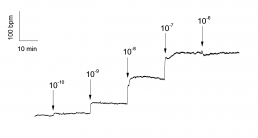
Typical cumulative effects of isoprenaline on spontaneous atrial beating rate.
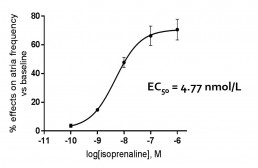
Concentration-effect curve of isoprenaline.
Reference CompoundsConcentration
Isoprenaline4.77 nM
Forskolin0.08 µM
IBMX7.48 µM
Inotropic effects
Cardiac contractility assays & secondary pharmacology
Contractility assays aim to identify potential inotropic effects (worsening of heart function) early during drug development. Numerous clinically approved drugs reported to modify systolic and diastolic function increasing the risk of cardiac dysfunction (arrhythmias, heart failure, left ventricular decompensation). As a result, a large number of drugs have been contraindicated with the use during late stage of clinical trials or from the market.
What is the added value of such a study?
- Strongly recommended for the secondary pharmacology of regulatory documents
- Threshold concentration of the target and off-target of cardiac contractility
- Prediction of the variation of inotropism
- Determination of appropriate In Vivo model
Organ baths
Technique
- Isolated organ baths system
- Papillary muscle electrically stimulated at 2 Hz (Guinea-Pig, Rabbit)
- 5 preparations tested and 5 control preparations (as basic design protocol but can be adapted)
- 3 cumulative increasing concentrations of assay compound
- Washout period or positive control at the end of the experiment
- In the presence or absence of inotropic or pro-ischemic agents
- Option: other stimulation rates
Measured parameters
- Twitch force is recorded using a force transducer.
- Systolic tension (Peak)
- Diastolic tension (Base)
- Developed tension (dF)
- Developed force recordings
- Upon request: Biomarkers assays
Main advantages
- Medium throughput screening
- Cost effective previous In Vivo model
- Fast process to delivery results
- Perfect at earliest stages
- Design protocol could be adapted
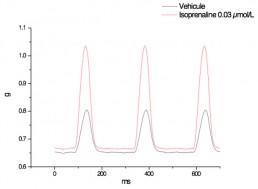
Typical effects of isoprenaline on developed force of guinea-pig papillary muscle.
Reference compounds
Reference compoundsConcentration
Isoprenaline 0.03 µmol/L
